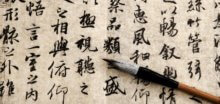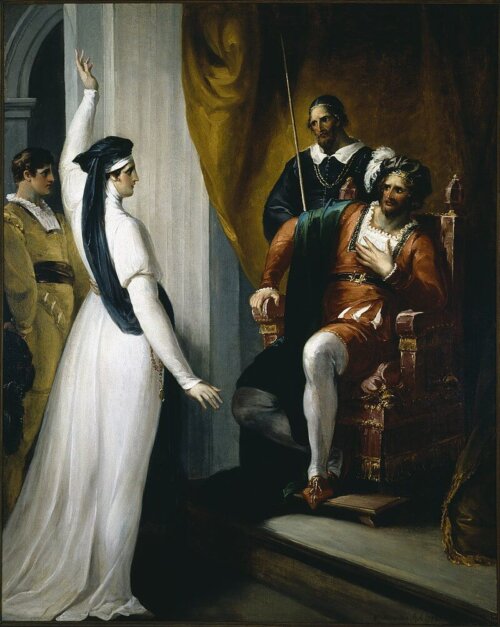Learning Chinese

There are lots of travel books, and most of them have the same structure:
Why I traveled to Upper Revolting;
What happened to me in Upper Revolting;
How I am a different person for having been to Upper Revolting.
Travel books are a species of autobiography, and autobiographies, after all, are at heart spiritual accounts.
Your essayist would like to suggest a new subspecies of travel books: journeys into learning.
We might have, for example, a book about how the author came to take up arc-welding and what she discovered. Or, we could find Travels through Lepidoptery. or, In Darkest Algebra.
Very scary.
Over the last few years we have been puttering away at classical literary Chinese, and what a long strange trip that has been! The impulse was an ill-defined bundle of motives–there was curiosity and a taste for Chinese poetry and a frustration at being unable to communicate, even a little, with a large portion of the globe. Also, possibly, we wanted to surprise the waiter in the local Chinese restaurant.
There is no action without an end, but often the end only becomes articulate deep into the process. Until then, it is cloudy or compact.
We found ourselves a text, an old standard from the University of Chicago, Literary Chinese by the Inductive Method by Herlee Glessner Creel, Chang Tsung-Ch’ien, and Richard C. Rudolph. It is a text from the thirties–there may be some reading this who have used it. Perhaps we could form an organization, The Old Boys of LCbtIM, and have annual dinners.
Then shall he strip his sleeve and show his scars
And say, I got these wounds from volume three . . .
Before we go on, we should qualify what we are going to say by pointing out that what we are dealing with is old fashioned, classical Chinese. Modern Chinese is a related but rather different game for the most part.
Report from the Kingdom of Learning Chinese
Anyway, the bruised and worn traveler now reports from the Kingdom of Learning Chinese.
Sorry, no magic lantern.
The sum of the adventure is: most of what we expected to be so, wasn’t. We had lots of preconceptions and the majority were wrong.
One reasonable expectation might have been that the learning of a language, almost any language, would be a unitary operation. I mean that we could learn to read Literary Chinese by reading Chinese. We learn Latin, for instance, mostly by reading Latin.
Not so, learning Chinese is two tasks, linked but separate. The student has the characters to master, but also the language.
Everyone is acquainted with Chinese characters as a phenomenon from childhood. It might be supposed that learning characters might be slow, but could be systematic. After all, doesn’t each individual character represent a concept? Cannot one move, in learning, from a character
e.g. 馬
to its meaning:
“horse”
and hence from “horse” to
“Mǎ” (the spoken word)?
Well, no, actually.
The iconographic factor in Chinese characters is far less than expected.
` 馬
may look (a little) like a horse, but
北 ( Běi)
looks like nothing whatever connected with “North.”
Further, one discovers, many of the compound characters include an element that is meant to give one a phonetic clue to the word. For example
木馬 (“ma” with a downward accent)
means “clamp.” The first element is Mù , meaning “tree.” “Tree-horse” means “clamp?” No. The tree bit means it’s made of wood, the second character indicates pronunciation. Unless you know the pronunciation of 馬 you will be at a loss. This pushes you back from learning Chinese characters into learning Chinese.
A Lot of Easy-to-Learn Short Words?
Well, fine. Will not the vocabulary, being for the most part monosyllables (classical Chinese, mind) be easy to learn?
Could not one could simply plug in new synonyms from English? To a previous range of synonyms
horse
steed
nag
oat-burner
could not one add a new element, i.e. “Mǎ”? Piece of cake.
Wrong. We gave this a real try, we did.
There are two obstacles.
First, it turns out that we can handle a set of synonyms for the same reality, only because each term in the set indicates a different reality.
“Horse” is what your daughter wants lessons on. “Steed” is what a knight rides on. “Nag” is what you bet the rent money on . . . So, to remember “Mǎ”, you have to ask yourself what the word means in a Chinese context.
Without this process, without learning that
車 (Chē)
to use another example, means not “Chariot” (something that has a Greek standing in it) but an analogous object in a Chinese context (often with an umbrella).
There is no reason for the memory to connect you with that particular vocable rather than any other.
So, that can take time.
The Chinese “Tones”
Second, before you can bring a word back from memory, you have to be able to hear the word accurately, and this is not a trivial task.
Everyone has heard of the “Tones” of Chinese and how difficult they are. Well, they are. And they make a difference, and it takes a long time to re-educate the Anglo ear.
But beyond that, the phonemes of Chinese map only very loosely onto our English set. As a result, half the words in Chinese sound, to us, exactly the same.
It is cheering to report that there is now considerable help on the web towards improving one’s pronunciation. Google translation has a audio feature and it is very handy. Unhappily for our case, we got used to using the old Wade-Gilles transcription–everything on the web is in Pin Yin. It turned out that the age of our text actually had some consequences.
The process of learning characters then is layered and frustrating. It is not to be thought that there are no rewards. Writing Chinese characters has a certain sensory quality not found in alphabets. And it is a pleasure to be using a system of writing that has been operative, day to day, since the time of the Hittites.
As familiarity grows, characters seen on signs move from being jumbles of stokes, into articulated patterns. Sometimes one can pick out a character one knows, and then sometimes, two or three. It makes up for a good deal of frustration. And this business is rich in frustration.
One of the things we noted was that the learning process draws one back, as it were, through several layers–from trying to learn characters, to trying to learn words, to trying to hear words accurately, and back to learning words as manifestations of the world in which they were spoken.Those who have read C.S. Lewis’s autobiography may remember his passage on the difference between ναυς (Greek for “ship”) and “Ship.”
Eventually the student will want to read something in his dearly bought Chinese (most people learn languages to read texts, a smaller number read texts as an excuse for reading a foreign language).
It is the great virtue of Literary Chinese by the Inductive Method, the text we got ahold of, that it launches you into texts from the first day–the first text is the Classic of Filial Piety, attributed traditionally to Confucius. You get the text and notes on vocabulary. After that, well it is the inductive method after all, or, to use an older term, the “throw’m in the pool” approach.
This plan of attack certainly is low on system, but it does have one great virtue: even if one goes only a certain way, one can tell oneself that one has actually read some Confucius. Not well, perhaps, and not much, but there it is. It is comparable to reading your first page of Plato in Greek or the first chapter of Genesis in Hebrew. Indisputably, you have now hit the real thing.
The real thing, as it is so often (you remember instances, yes you do!), is a bit of a surprise. It is especially startling to those of us who have grown up with Latin and Greek, or French and German and Spanish. All of these languages come with elaborate, sometimes baroque, grammatical machinery, and the point of it all was to make sure you had every clue you needed to understand the text accurately.
A Notable Shortage of Grammar
Chinese works on the opposite principle. It is not true there is no grammar in Chinese. What is true is that there is very little explicit grammar. No case endings, no declensions, no μεν and δε, no bloody “indirect discourse.”
What the Chinese writer says is often so terse as to be enigmatic. These are the first few words of the Analects, translated literally:
子 曰 學 而 時 習 之 不 亦 說 乎
Zǐ yuē xué ér shí xí zhī bù yì shuō hu
he say study and times practice it not also pleasure right?
Confucius is humane, insightful and often funny, but his remarks seem to Western minds like point form outlines. It is as if he were speaking to someone who already knew most of what he had to say.
And in truth he is. And this leads to the central secret of Classical Chinese: you are not supposed to be reading this.
By “you” we mean the non-Chinese. Of course you can, there’s no law against it, but Confucius would have found it tolerably peculiar.
In the Classical Chinese context, the young person learned to write at home from a tutor. It was a respectable home; in non-respectable families everyone was supposed to be planting rice. The tutor taught the characters; he introduced the child to the proper books and told him (only him, never her) what it was supposed to mean. If it was terse, that made it easier to remember. At the end of the educational program, the child had read everything it was gentlemanly to read and understood it as a gentleman was supposed to understand it.
Anyone found learning to read outside this respectably context was probably
(a) a revolutionary, or, and much worse,
(b) an arriviste.
Certainly no one to call upon socially.
As for a barbarian learning Chinese, Confucius would have found it touching, but frankly, well, amusing. Dr. Johnson’s dog comes to mind.
Does this sound satirical? Let us remind ourselves, that this was the orthodox Western attitude right up into the nineteenth century. Those interested may consult The Intellectuals and the Masses by John Carey
Learning Classical Chinese needs determination, a good memory, an active intuition, and cheerful humility.
The reward is to become a stranger on planet Chinese Culture, but gradually less and less a clueless stranger.
One also becomes aware, after a little progress, that a mountain range of material is becoming, in theory, accessible. Again, readers may remember the realization that, having now learned enough Greek for the Apology, if one was bound to read Aristotle, it would have to be read, for the sake of honour, in Greek. The Penguin edition had become a cop-out.
And it may allow you to try out a few phrases on the waiter or an academic from the mainland. They will be gratified and will tell you so, as soon as they stop laughing. But they will do it politely.
Your columnist was sitting with his notebook on a streetcar some time ago, when he was tapped on the shoulder. An elderly Chinese inquired, politely, if one was learning Chinese. Qualified affirmative. “That’s Confucius,” he said, pointing at the notebook, and got off.
To do good in secret, and be caught out by chance, is gratifying, and the same seems to apply for amateur scholarship.




